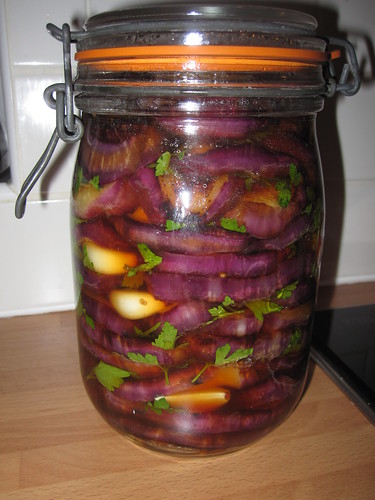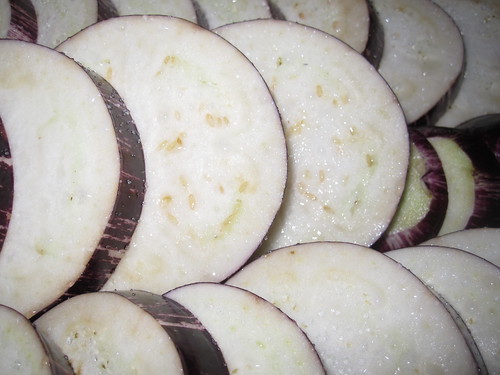
Ingredients
~1 kg aubergines, about 4
salt
oil for frying
1 dl cider vinegar
1 dl water
peeled cloves of garlic, about a head and a half
sprigs of parsley (optional)
Method
- Trim off the stalks and wash the aubergines. Then slice into circles, about 1 cm thick.
- Sprinke each circle with salt on both sides and stack slightly overlapping on a baking tray or a roasting rack over a baking tray.
- Lean the tray at one end so the liquid of the aubergines drains into the tray easier. Leave for a couple of hours.
- Peel the garlic and wash the parsley and shake off excess water. Prepare a 1 litre jar and several sheets of kitchen tissue.
- Heat up a little oil in a deep saucepan on high.
- In a bowl, mix together the cider vinegar and water.
- Carefully squeeze out each aubergine circle of liquid, then pat dry on a sheet of kitchen tissue and fry for a couple of minutes on each side, so they get a little colour.
- Transfer to the bowl of vinegar/water mixture, while putting the next batch in to fry.
- After a couple of minutes move the aubergines from the vinegar/water mixture to the jar, layering as densely as possible and add a couple of cloves of garlic and a few sprigs of parsley between each layer.
- Continue with the remaining aubergines, adding oil to the frying saucepan as required, but not too much.
- Any left-over vinegar/water mixture can be poured into the jar. Press down on the aubergines as much as possible to squeeze out any air.
- Close the jar and leave to cool down to room temperature. Then store in the fridge, however the aubergines are pretty much ready to eat.
My Mum takes the time to cut the aubergines into strips to make it look like herring fillets, but I did circles, as this was the instruction of the original recipe. However, I think strips would be easier to pack in the jar, I ended up with quite a few gaps between each layer, but I did my best to press down.

Amazing how much liquid they contain!
Update 12th January:
These turned out spot on and were super tasty, we got through them alarmingly quickly.
So I immediately bought double the amount and used my mandolin to slice the aubergines length-wise. The mandolin cut them a bit thinner than I'd intended and what I did manually during the first run, but there is no way I'd risk cutting off my fingers attempting to cut an aubergine lengthwise with a knife.
There were so many of them, I had to make these over two days and even then I had to bake them in several batches, the slices lined next to each other onto a roasting rack and brushed lightly with grapeseed oil.
Because I'd doubled the amount, I also needed to double the pickling mixture and I still ran out and had to do a further half of the above amount. I also used a large spoon to press them down in the jar and used a metal skewer to remove all the bubbles I could see.
Initially the flavour was a bit different and I thought it was down to baking rather than frying, but in hindsight, I think they just needed a bit longer in the jar before starting to eat them and possibly using more of the pickling mixture to start with. But they were just as nice and I discovered they worked a treat between to toasted slices of bread, no need for butter or anything like that. And they do last long too.
A word of warning on the garlic - it is very tasty, but also very strong in flavour and your breath will smell for days. So I recommend using in stews and soups instead of fresh garlic.
No comments:
Post a Comment